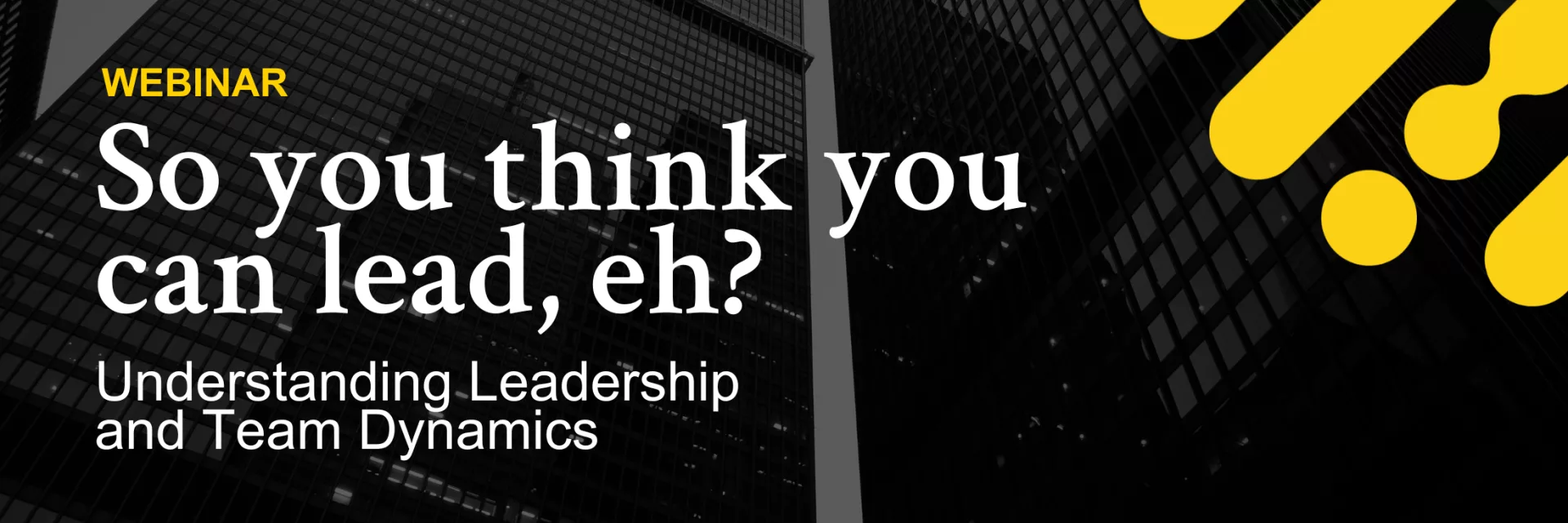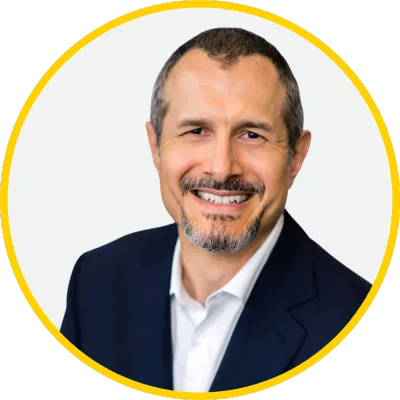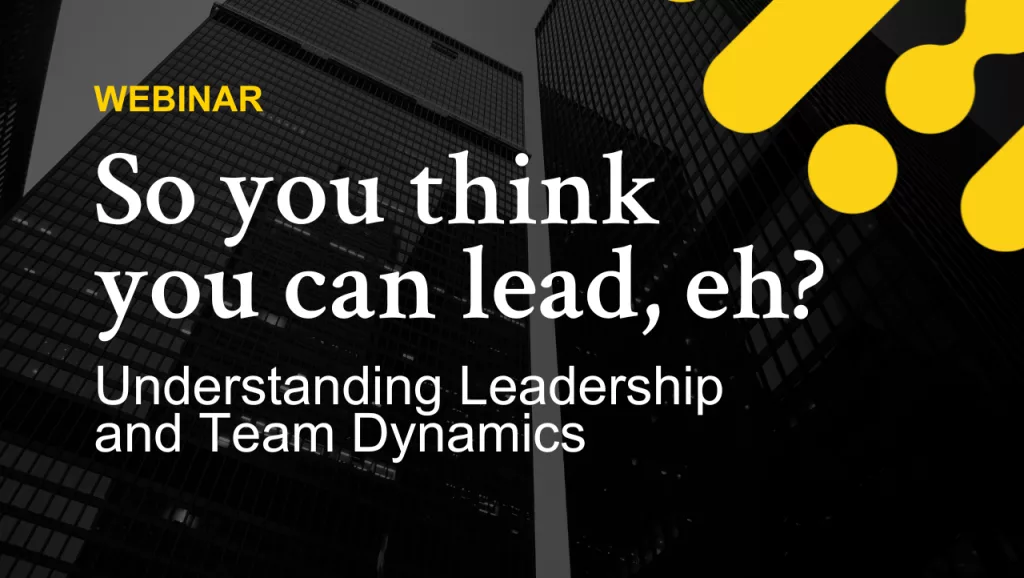Understanding leadership and team dynamics
DATE:
Wednesday, May 8, 2024
TIME:
from 11:00 am to 12:00 pm (EDT) | 9:00 am to 10:00 am (MDT)
Session ended – Recording now available
DATE:
Wednesday, May 8, 2024
TIME:
from 11:00 am to 12:00 pm (EDT)
9:00 am to 10:00 am (MDT)

About the webinar
Most of us have been on teams that were great and others—if we’re being honest—that weren’t so great. What are the characteristics and habits of highly effective teams? What role do leaders play in getting teams to the next level? And crucially, what actionable steps can leaders and team members at all levels—from team leaders to senior executives—take to support excellence while avoiding common pitfalls?
Between them, our experts Bernard Letendre and Tom O’Neill bring together the science of leadership research with real-life experience in senior executive leadership roles. In this insightful webinar, they will share their wealth of knowledge and experience, delving into the intricacies of executive leadership teams, dissecting what truly defines a team, and uncovering the essence of high-performing teams.
Whether you’re a seasoned leader seeking fresh insights or looking to understand the dynamics of effective teams, this webinar promises to provide an enriching discussion that will leave you inspired and equipped with actionable insights.
We look forward to seeing you there!
Please note that this webinar is offered by Humance free of charge.
Our experts
As a partner in Humance’s Leadership & Team Development division, Bernard helps organizations drive performance through meaningful culture. Over the course of his nearly 30-year corporate career, he has occupied executive and senior executive positions in some of Canada’s largest financial institutions. This has given him a unique vantage point from which to observe and understand complex organizational issues, including matters related to talent development, succession planning, and organizational effectiveness. Now an entrepreneur and co-owner of Humance, Bernard brings his experience to bear for the benefit or organizations of all sizes.
To help people do and be their best, Bernard combines his extensive real-life leadership experience in complex, global organizations with the values and wisdom of traditional martial arts, maieutics, and elements of sport coaching. He has written over 100 blog articles on matters related to people, teams, culture, values, and organizational performance.
A UBC Certified Organizational Coach (COC) with an ACC designation from the International Coaching Federation (ICF), Bernard holds a bachelor’s and a master’s degree in law from the University of Montreal, has been a member of the Quebec Bar since 1993, and is an accredited mediator. Holder of a third-degree black belt, he has been practising judo for over 40 years and teaching it for almost two decades. A certified Dojo instructor (NCCP Level 2), he is Technical Director of the University of Toronto Judo Club.

Bernard Letendre
Partner | Leadership & Team Development
LLB, LLM, COC, ACC
As a partner in Humance’s Leadership & Team Development division, Bernard helps organizations drive performance through meaningful culture. Over the course of his nearly 30-year corporate career, he has occupied executive and senior executive positions in some of Canada’s largest financial institutions. This has given him a unique vantage point from which to observe and understand complex organizational issues, including matters related to talent development, succession planning, and organizational effectiveness. Now an entrepreneur and co-owner of Humance, Bernard brings his experience to bear for the benefit or organizations of all sizes.
To help people do and be their best, Bernard combines his extensive real-life leadership experience in complex, global organizations with the values and wisdom of traditional martial arts, maieutics, and elements of sport coaching. He has written over 100 blog articles on matters related to people, teams, culture, values, and organizational performance.
A UBC Certified Organizational Coach (COC) with an ACC designation from the International Coaching Federation (ICF), Bernard holds a bachelor’s and a master’s degree in law from the University of Montreal, has been a member of the Quebec Bar since 1993, and is an accredited mediator. Holder of a third-degree black belt, he has been practising judo for over 40 years and teaching it for almost two decades. A certified Dojo instructor (NCCP Level 2), he is Technical Director of the University of Toronto Judo Club.
Tom is a professor of Industrial and Organizational Psychology at the University of Calgary, and a leading scholar in the areas of high-performance teamwork, executive leadership teams, team coaching, conflict management and communication, and culture transformation. As an instructor for 20 years, with 15 years of active management consulting, he brings a very well-rounded and evidence-based approach to solving organizational problems.
Tom has published over 90 peer-reviewed journal articles in outlets such as Journal of Applied Psychology, Journal of Management, Academy of Management Learning and Education, and Human Resource Management Review and has translated the science of organizational psychology into practice through consultations, workshops, public lectures, trainings, and other services. He co-founded Work EvOHlution, which specializes in hybrid and remote work, and was acquired by Humance in 2021. Tom teaches High-Performance Teamwork in the Haskayne School of Business Executive Education in the programs involving senior and emerging leaders, and in the Strategic Leadership Development Program. In these programs he has focused on the leadership skills needed to build and maintain high-performance teamwork including direction and purpose, empathetic listening, creating role clarity, and optimizing interdependence. His current consulting engagements focus on executive leadership team development, organizational strategy, culture transformation, managing the hybrid workplace, and psychometric assessment development and validation. Tom edited a book with co-authors called The Handbook of Virtual Work (2023).

Tom O'Neill
Senior Consultant | Leadership & Team Development
Professor, University of Calgary
PhD
Tom is a professor of Industrial and Organizational Psychology at the University of Calgary, and a leading scholar in the areas of high-performance teamwork, executive leadership teams, team coaching, conflict management and communication, and culture transformation. As an instructor for 20 years, with 15 years of active management consulting, he brings a very well-rounded and evidence-based approach to solving organizational problems.
Tom has published over 90 peer-reviewed journal articles in outlets such as Journal of Applied Psychology, Journal of Management, Academy of Management Learning and Education, and Human Resource Management Review and has translated the science of organizational psychology into practice through consultations, workshops, public lectures, trainings, and other services. He co-founded Work EvOHlution, which specializes in hybrid and remote work, and was acquired by Humance in 2021. Tom teaches High-Performance Teamwork in the Haskayne School of Business Executive Education in the programs involving senior and emerging leaders, and in the Strategic Leadership Development Program. In these programs he has focused on the leadership skills needed to build and maintain high-performance teamwork including direction and purpose, empathetic listening, creating role clarity, and optimizing interdependence. His current consulting engagements focus on executive leadership team development, organizational strategy, culture transformation, managing the hybrid workplace, and psychometric assessment development and validation. Tom edited a book with co-authors called The Handbook of Virtual Work (2023).
Webinar recoding
We invite you to view the webinar recording!
Q&A
Our experts’ answers to your questions!
1. How do you develop trust among team members?
2. To be trusted or to be liked? What are the differences? Are they the same?
Tom: See response to next question—and being trusted is more important than being liked. You may not be friends with all your colleagues, but a strong foundation of mutual trust is essential for an effective working relationship. You don't need to like everyone you work with, but trust is crucial for collaboration and productivity.
3. How "friendly" should you be to your team members as a leader?
Tom: As a leader, you are a colleague, not necessarily a friend. While it's fine if friendships develop, it's crucial to maintain professional boundaries. Building professional relationships is key, but trust is paramount.
4. How can we build trust in an inclusive way?
Bernard: I agree with Tom that finding common ground is essential for building trust. However, trust can also be built in other ways. For instance, there are people I trust completely despite knowing very little about them. As I’ve written previously “Mutual benefit is one of the strongest foundations for enduring trust and collaboration that I can think of.” I offer more on this important concept here.
5. How can we measure good leadership?
Bernard: Also see my response to question 7. I would also recommend considering Ivey’s Leader Character Framework, which complements Tom's approach by emphasizing various leader character dimensions. More details can be found here.
6. How do we address leaders who do not lead in a people-first manner?
Tom: It is essential to understand the perspective from which this issue arises, be it from a leader, direct report, peer, or client. Generally, try to earn their trust and approach them with influence, coaching, and mentoring. Developing skills for handling difficult conversations can also be beneficial. Asking insightful questions, such as “How do you support and take care of your people?” can open up constructive dialogue.
7. What scientific proof supports human-centered leadership benefiting the bottom line?
Bernard: Fred Kiel’s research offers valuable insights. In a study involving over 100 CEOs and 8,000 employees, Kiel found that companies with leaders rated highly on integrity, responsibility, forgiveness, and compassion—traits of high character—achieved up to five times the return on assets compared to companies with leaders of weak character. He refers to this advantage as the "return on character." Additional insights can be found here. Moreover, research by Gordon Wang and Rick D. Hackett, as well as Mary Crossan and colleagues at Ivey Business School, supports the significant impact of leadership on organizational performance and moral identity.
"There is considerable evidence that leadership can influence the moral identity of followers" – Written by Gordon Wang and Rick D. Hackett
"Organizations that fail to hire for and develop positive character among its leaders are missing an opportunity." – Observation of Mary Crossan and her colleagues
8. How do you deal with a leader who has contempt for the experts on their team? What can the team do?
Bernard: A leader who has contempt for people on their team? “Contempt” is a powerful word and I assume it was chosen deliberately. To build on Tom’s response, I would say that addressing a leader who shows contempt for their team requires courage. As I have previously written, “if employees where you work have to tap into deep wells of courage on a regular basis in the normal course of doing their job, you’re part of a dysfunctional organization.” Read the full article. . If circumventing the leader is necessary and there is a moral imperative to do so – as a matter of integrity, for instance – leveraging key allies within the organization may offer an informal path to ensure critical information reaches the right people.
9. When transforming an organization, how should leaders navigate ambiguity?
Bernard: To lead through ambiguity: 1- Articulate a clear case for the change 2- Involve people in co-creating the solution. 3- Give it time for the process to unfold. More details on this approach can be found here.
10. Why do we tend to anoint bombastically extroverted leaders?
Bernard: It's unclear if this is entirely accurate.
11. What role does individual leadership play, if any, on high-performing teams?
Tom: Individual leadership plays a huge role. You should lead according to your strengths and what the team needs from you in your role, whether that involves unique expertise, personality, attitude, or skills. Everyone must step up and lead in areas that benefit the team. Equally important is knowing when to step back and allow others to lead. It’s a dynamic and collaborative process—it’s a dance.
12. A lot of teams are good or bad in different ways. If you were to focus on one thing to improve team performance, what would it be?
Tom: Focus on answering fundamental questions about the team's existence and purpose: Why are we here? Why does this team exist? What is our purpose? Who do we serve? What if we weren’t here? What if we fail? Establishing a higher meaning through an unfolding series of conversations—not authoritatively—can make the rest of the challenges easier to address.
13. What are some effective ways to bridge upper management and team perceptions?
Tom: Bridging this gap requires a higher level of leadership consciousness and self-awareness at the organizational level. The book Mastering Leadership by Anderson and Adams, along with the Leadership Circle assessment, can be useful tools. That assessment allows lower-level teams to rate upper management, which can create self-awareness if handled right.
The issue often stems from a lack of trust and insufficient or unidirectional communication. Increasing social contact and fostering bidirectional communication can help. Upper management is often focused on deliverables, partners, boards, stock valuations, and other KPIs, leaving little time for proper communication. Despite the challenges, if leaders can unify the company, create strategic coherence, and raise the consciousness of leadership, the organization is more likely to become resilient and stand the test of time and change.
14. I am assisting a company in Georgia as an Interim President for 3-6 months. What are my top 3 priorities—30-60-90-days?
Tom: Your top three priorities should be to listen, listen, and listen. Meet with as many people as possible and ask non-threatening, open-ended questions. By the end of the 90 days, you should have a comprehensive assessment of the organization’s state and be able to set clear priorities.




Tom: Developing trust involves creating an emotional connection, demonstrating competency in work tasks, and most importantly, maintaining consistency. Being authentic and sharing personal aspects, such as upbringing, family life, and personalities, helps build emotional connections. Additionally, consistently delivering high-quality work and being reliable fosters trust. Building trust should not be hard to do—it has been crucial to our survival as social animals. Unfortunately, some people exploit trust for short-term gains, which rarely ends well and is morally wrong.